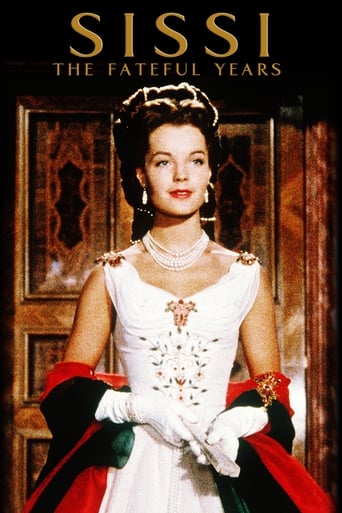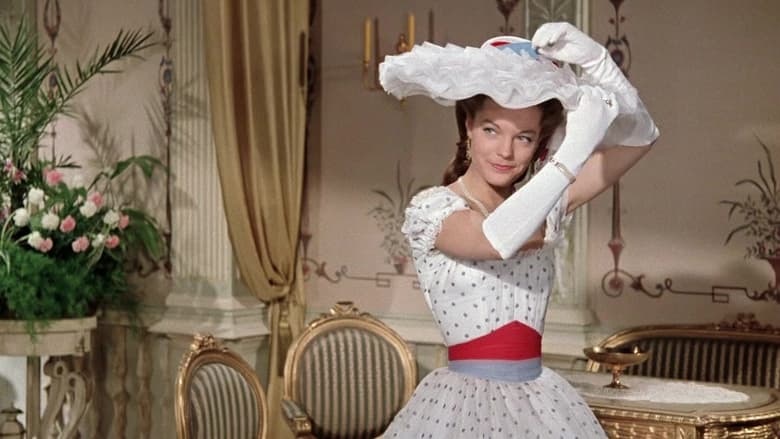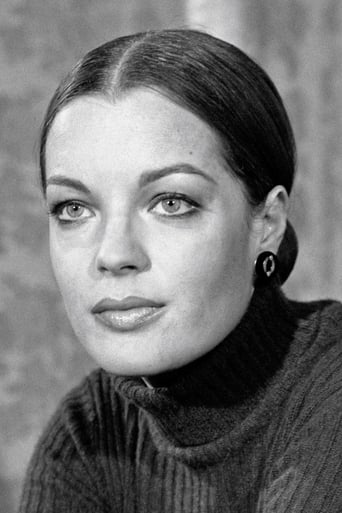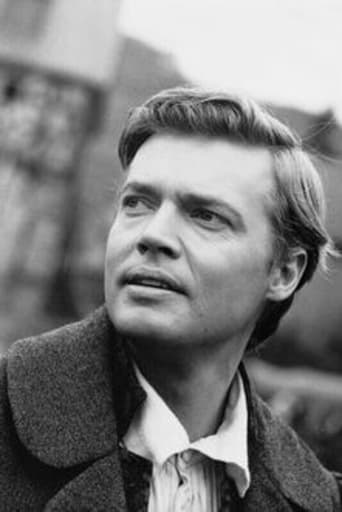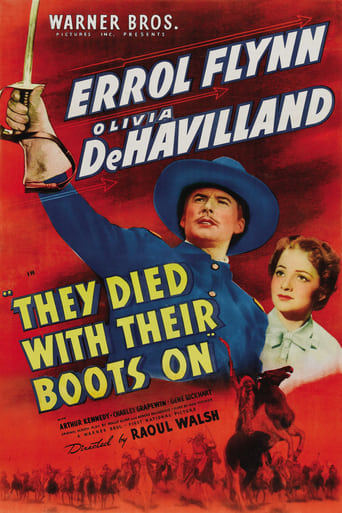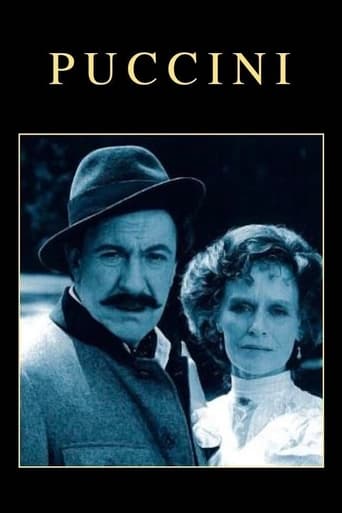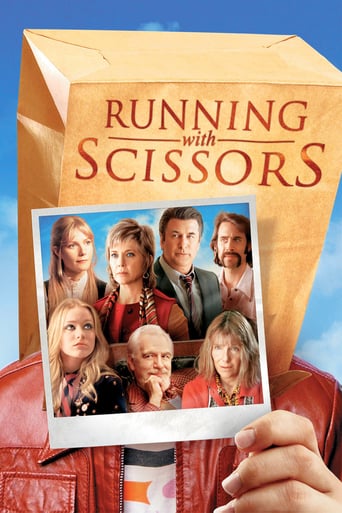Sissi: The Fateful Years of an Empress (1957)
After a wonderful time in Hungary Sissi falls extremely ill and must retreat to a Mediterranean climate to rest. The young empress’ mother takes her from Austria to recover in Madeira.
Watch Trailer
Cast


Similar titles
Reviews
Awesome Movie
Absolutely the worst movie.
This is a must-see and one of the best documentaries - and films - of this year.
It is an exhilarating, distressing, funny and profound film, with one of the more memorable film scores in years,
The final film in the Sissi trilogy - The Fateful Years of the Empress -- again stars Romy Schneider as Empress Elisabeth of Austria. These films are beloved by the European public, just as some of the Disney films we saw as children are to us.As far as history goes, the movies are not very accurate, though they do show real events. Sissi and her husband are portrayed as very much in love, a very romantic couple, although that was not true. Also, for the purposes of this film, their daughter Sophie actually lives, and there aren't any other children. Actually the whole end of this film in Venice, in history, took place much later in Sissi's life, and her son Ludwig was present.One interesting fact is that, as in the film, Sissi's brother married the actress Henriette Mendel, and she was made a Baroness. Their illegitimate daughter, who appears as a character in the movie, becomes Marie Larish. Marie Larish was the go-between for Elisabeth's son Ludwig and his fiancé Mary. After the Mayerling scandal, when Ludwig shoots Mary and then himself, it was learned that Marie served as go-between, and the family, including her close companion Sissi, completely disowned her.During the time that Sissi spends in Hungary, there were rumors that Count Andrassy was her lover, but this was never proved. The film is so whitewashed that a liaison would never have occurred to Sissi. Sissi does become very ill -- they suspect tuberculosis -- and is sent to Madeira to recover. However, it is believed that her condition was very much psychosomatic -- she really didn't like being at the palace -- because, unlike in the film, when she arrived in Madeira, she had a miraculous recovery. In the film, she remains ill until her mother arrives and gets her walking, etc.This film ends with the Emperor and Empress' triumphant appearance in Venice. Marischka planned on doing a fourth film, but Romy Schneider refused, turning down one million Deutschemarks. Schneider would become Elisabeth once more, in 1972, in the film Ludwig, playing the character closer to the real Sissi.The costumes, the scenery, the pageantry in this film is spectacular. Romy Schneider is fresh and beautiful and luminous as Empress Elisabeth, not at all the dark, anorexic character described in history as time went on.Sissi's end was tragic, as was Schneider's, but Europeans, so beaten down by war, were in the mood for something beautiful, and they got it with the Sissi films. She is such a beloved character there, like Princess Diana, audiences loved this view of her life.To be enjoyed as a real feast for the eyes.
The last of the three Sissi movies continues with the idealized version of her story. Just like in Disneyland, no one ever ages and all ends well. This third film shows events that probably did happen sometime during her 45 years on the Austrian throne, but by now the overall story can only be called fiction. The second movie ended with the coronation of Sissi and Franz Josef as King and Queen of Hungary. That happened in 1867. By that time, Sissi gave birth to three children - Sophie in 1855, Gisela in 1856, and Rudolf in 1858. Her firstborn Sophie died in 1857. A fourth child, a daughter, was born in 1868. Yet this third film, presumably a continuation of the second film, shows the imperial couple visiting Venice, which happened in 1856, and shows only one child, a girl, who appears to be about 4. So the chronology is obviously all wrong here. While the illness she suffers from in this movie is based on fact, Sissie should have aged in the movie about two decades by the time these events were presented. I gave this movie a relatively low mark because of the many historical inaccuracies and omissions. In spite of these shortcomings, I still enjoyed the movie. This third movie includes some breathtaking scenery of the Mediterranean coastline, and the Venice visits appears to have been shot on location. One almost feels like a part of the crowd. Franz Josef likewise seems to be forever young and is not shown with the facial hair that distinguished him for most of his reign. He already sported the beard and mustache by the time he was crowned King of Hungary in 1867, so he should have had the facial hair already by the end of the second movie and throughout the entire third movie. But that would probably spoil the Prince Charming image the film makers were aiming for. This movie should be viewed more as a fairy tale that is loosely based on the life of the imperial Austrian family. It is not an historically accurate portrayal of their life story.
The third part of Sissi trilogy is made in the same convention as the previous two parts: monumental scenes with a lot of historical inaccuracies, sweetness, and high morality. However, if there is any uniqueness of this part, it is its most tragic content. As a result, Sissi-Schicksalsjahre einer Kaiserin, which can be translated as "the fateful years of the empress", is closest to the historical picture of this person - one of the most tragic empresses and one of the most known figures of the Austrian history.The first half takes place in Hungary. Sissi, the queen of Hungary, stays in a lovely place, Godolo, far from the loneliness of the royal palace in Vienna, and her cruel mother in law, archduchess Sophie. Although she loves her time there, she leaves Hungary when Count Andrassy's love gets stronger. However, there remains one trace in her from the time spent riding horses and relaxing in Godollo. Sissi falls into tuberculosis. She has to leave Vienna for an exotic southern place to change the climate. It is Madeira and Korfu. There are long scenes of her recovering, her mother Ludovika (Magda Schneider) comes to her, to Madeira, and gives her hope to recover. There is a reference of long scenes to the tiring process of recovering. But they are not boring thanks to gorgeous views of the Italian coast.The part is equally classic as the previous ones. Great cast including Romy Schneider, her mother Magda Schneider, and Karlheinz Bohm, still living. Filming locations are also an aspect worth considering. For that time, it was really extraordinary to make the movie on the Amalfi Coast (southern Italy) or Venice. Most scenes of Madeira and Korfu are particularly shot in an idyllic town of Ravello with its wonderful villas, Villa Cimbrone and Villa Rufolo. There is also Paestum with its ancient temples and, of course, Saint Mark's Square in Venice at the end of the movie.The final scene is the most memorable of all. Sissi, having recovered from tuberculosis, travels with Franz Josef to Venice (an anti-Austrian part of the empire). The picture of the imperial gondola embarking near St Mark's Square is strikingly based on the various pictures from the 19th century presenting the imperial visit to this beautiful and unique city. The silence of the crowds is widespread. While the imperial couple walk towards Saint Mark's basilica, Sissi suddenly notices her little daughter whom she could not meet due to her illness. Not caring for the people watching, she runs to her daughter, kisses her and cries out of joy. Someone from the crowd starts to salute and after a few seconds the whole Saint Mark's Square turns into a cheerful place. The people do not shout "VIVA" to adore the empress but the MOTHER. "Blessed are the ones of joyful hearts, for joy comes from God"(one notice: the anthem that is played while the imperial family enters the basilica is not the German anthem but the old Austrian anthem of the same melody "Gott Erhalte, Gott Schutze Unseren Kaiser, Unseres Land")You may have one doubt to this final scene. The story somehow does not end. The imperial couple is in Venice, Sissi is well, happy, and what then? Marischka planned to make the fourth part but Romy Schneider refused. She was fed up with being associated with Sissi. She was an actress and not an empress and that was a good decision. More great films waited for her life career. The role of Sissi in 1957 was not the lat one Romy had. She played Elizabeth of Austria one more time in Visconti's Ludwig almost twenty years later, but this was an entirely different portrayal.Sissi Schickslsjahre einer Kaiserin is a classic, beyond times. Generations to come will watch it as a treasure of the Austrian cinema of the 20th century. FOREVER IN MY FAMILY'S FILM COLLECTION
Like the first two Marischka movies ,and although nobody sings in these movies,they are closer to operetta than to cinema.Maudlin and syrupy to a fault,they nonetheless retain a kitsch charm.I must confess I love this exponentional schmaltz.History is given a rough ride,this is an euphemism,although most of the events that are depicted here did happen: Sissi's brother did marry an actress, a misalliance,and the adorable little girl whom Sissi's mother pampers would later be Marie Larish who would play a despicable prominent part in the Mayerling tragedy.The Hungarian part would occur later in Sissi's life,(her son Rudolf was present) and Andrassy's flame was purely fictional.While watching such candid pictures ,listening to lessons in wisdom and kindness,we almost forget that Sissi's fate was in fact a very dark one,and that her husband was still here when WW1 broke out.Afgacolor pictures are delightful and the ending is guaranteed to make the impressionable use two boxes of Kleenex.Romy Schneider made a volte face after Sissi the third.She turned down a one million marks offer,and despite her mother Magda -who plays her fictional mother and who was the star of Max Ophuls's "liebelei",left for broader horizons:she was to meet Visconti and Welles at the beginning of the sixties.A far cry from Sissi.She played "Sissi " again in 1972 in Viconti's "Ludwig" and she used to say that the Italian master was the only one who showed Elizabeth as she was.But Sissi is a dear memory ,particularly if you saw it when you were a child.You remember it like some kind of fairy tale in some faraway magic kingdom where every dream can come true.Or something like that.

